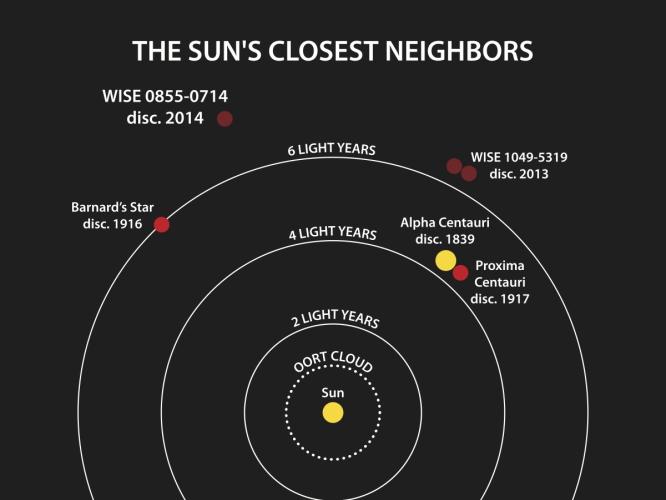The enduring mystique of Barnard’s Star
Larry Sessions in ASTRONOMY ESSENTIALS | November 14, 2018
Sometimes called Barnard’s Runaway Star, it’s one of the best known stars in the history of astronomy and in popular culture.
Our sun’s closest neighbors among the stars, including Barnard’s Star. Image via NASA PhotoJournal.
Perhaps you know that, over the scale of our human lifespans, the stars appear fixed relative to one another. But Barnard’s Star – sometimes called Barnard’s Runaway Star – holds a speed record of sorts as the fastest-moving star in Earth’s skies. It moves fast with respect to other stars because it’s relatively close, only about 6 light-years away. What does its fast motion mean? It means Barnard’s Star is nearby, and also that it’s not moving with the general stream of stars around the Milky Way’s center. Instead, Barnard’s Star is merely passing through our neighborhood of space. Relative to other stars, Barnard’s Star moves 10.3 arcseconds per year, or about the width of a full moon in 174 years. This might not seem like much. But – to astronomers – Barnard’s Star is virtually zipping across the sky.
But, of course, that’s not the only reason this star is famous!
Barnard’s Star in history and popular culture. Yerkes Observatory astronomer E. E. Barnard discovered the large proper motion of Barnard’s Star – that is, motion across our line of sight – in 1916.
He noticed it while comparing photographs of the same part of the sky taken in 1894 and again in 1916. The star appeared in significantly different positions, betraying its rapid motion.
Later, Harvard astronomer Edward Pickering found the star on photographic plates taken in 1888.
Barnard’s star came to our attention barely 100 years ago and can’t be seen with the human eye, so the ancients didn’t know about it. It doesn’t figure into the lore of any constellation or cultural tradition. But that doesn’t mean that it doesn’t a have certain mystique about it that extends beyond the known facts.
For example, even as long ago as the 1960s and ’70s – long before successful planet-hunters like the Kepler spacecraft – there were suggestions that Barnard’s Star might have a family of planets. At that time, reported discrepancies in the motion of the star led to a claim that at least one Jupiter-size planet, and possibly several planets, orbit it. Although the evidence was disputed and the claim now largely discredited, there has remained a chance of planetary discoveries. And, indeed, in November 2018 an international team of astronomers announced it was “99 percent confident” that a planet for Barnard’s Star has now been found.
The long-standing rumor of planets for Barnard’s Star secured this star’s place in science fiction. It’s featured in, for example, “The Hitchhiker’s Guide to the Galaxy” by Douglas Adams; “The Garden of Rama” by Arthur C. Clarke and Gentry Lee; and several novels of physicist Robert L. Forward. In these works, the fictional planets of Barnard’s Star are locations for early colonization or way-stations for exploration further into the cosmos.
Barnard’s Star also was the hypothetical target of Project Daedalus, a design study by members of the British Interplanetary Society, in which they envisioned an interstellar craft that could reach its destination within a human lifetime.
And Barnard’s Star has been featured in online games.
Clearly, Barnard’s Star captures peoples’ imaginations!
How to see Barnard’s Star. Barnard’s Star is faint; its visual magnitude is only about 9.5. Thus this star can’t be seen with the eye alone.
What’s more, its motion – though large in astronomical terms – is still too slow to be noticed in a single night or even easily across a human lifetime.
Since Barnard’s Star can’t be seen without powerful binoculars or a telescope, finding it requires both experience and perseverance. It is located in the direction of the constellation Ophiuchus the Serpent Bearer, which is well placed for viewing on June, July and August evenings.
Because Barnard’s Star is a telescopic object, details on how to observe it are beyond the scope of this article, but there are procedures available online here.
The science of Barnard’s Star. The fame of Barnard’s Star is in its novelty, the fact that it moves fastest through Earth’s skies. But its real importance to astronomy lies in the fact that being so close, it is one of the best sources for studying red dwarfs, the most abundant stars in the universe.
With only about 14 percent of the solar mass and less than 20 percent of the radius, it would take roughly seven Barnard’s Stars to match the mass of our sun, and 133 to match our sun’s volume.
Like all stars, Barnard’s Star shines via thermonuclear fusion, changing light elements (hydrogen) into more massive elements (helium), while releasing enormous amounts of energy. Even so, the lower mass of Barnard’s Star makes it about 2,500 times less powerful than our sun.
In other words, Barnard’s Star is much dimmer and cooler than our sun. If it replaced the sun in our solar system, it would shine only about four ten-thousandths as brightly as our sun. At the same time, it would be about 100 times brighter than a full moon. No life on Earth would be possible if we orbited Barnard’s Star instead of our sun, however. The much-decreased stellar heat would plunge Earth’s global temperatures to hundreds of degrees below zero.
Although very common, red dwarfs like Barnard’s Star are typically dim. Thus they are notoriously faint and hard to study. In fact, not a single red dwarf can be seen with the unaided human eye. But because Barnard’s Star is relatively close and bright, it has become a go-to model for all things red dwarf.
At nearly six light-years‘ distance, Barnard’s Star is often cited as the second-closest star to our sun (and Earth). This is true only if you consider the triple star system Alpha Centauri as one star.
Proxima Centauri, the smallest and faintest of Alpha Centauri’s three components, is the closest known star to the sun at just 4.24 light years away. It, too, is a red dwarf. So Barnard’s Star is only the second-closest red dwarf star. It is perhaps more important for astronomical purposes, though, because Proxima is four times fainter and thus harder to study.
Special thanks to David J. Darling and Jack Schmidling for their help with this article.
 |
 |
|
|||||||||||
 |
 |
||||||||||||
|
|
|
|
|
|
|
||||||||
 |
|
|
|
|
|
 |
|||||||
|
|
|
|
|||||||||||
|
|
|||||||||||||
|
|
|
|
|
|
|
|
|
|
|
|
|
|
|
Results 1 to 1 of 1
-
11-15-2018, 01:25 PM #1
Barnard’s Star is merely passing through our neighborhood of space
Beginner's Guide for Rocket, NFPS and IKS66...
http://iptvtalk.net/showthread.php?2...-you-should-do
Kodi Options for Rocket, NFPS and IKS66...
http://iptvtalk.net/forumdisplay.php?71-Kodi
Check the Announcement Section...
http://iptvtalk.net/forumdisplay.php...-Announcements
Similar Threads
-
Coming Soon to a Neighborhood Near You...
By 4me2c in forum Chit Chat LoungeReplies: 2Last Post: 01-01-2021, 05:15 PM -
I am passing this on....
By bwcbob in forum Jokes/Humor Forum in honor of bwcbobReplies: 3Last Post: 11-07-2020, 04:57 AM -
I am passing this on ...
By bwcbob in forum Jokes/Humor Forum in honor of bwcbobReplies: 1Last Post: 07-02-2019, 06:18 PM -
i need the best rom for an M8 box im passing on to friend
By asboman in forum OTT M8 4K Android TV BoxReplies: 0Last Post: 10-05-2016, 11:30 PM -
Passing the buck
By juan_vale in forum IPTV Private Server (IPTV66)Replies: 8Last Post: 03-01-2016, 12:52 AM







 Reply With Quote
Reply With Quote